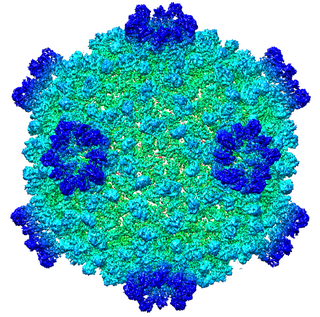
Nanoviridae is a family of viruses. Plants serve as natural hosts. There are currently 12 species in this family, divided among 2 genera and one unassigned species. Diseases associated with this family include: stunting. Their name is derived from the Greek word νᾶνος, because of their small genome and their stunting effect on infected plants.
Mardivirus is a genus of viruses in the order Herpesvirales, in the family Herpesviridae, in the subfamily Alphaherpesvirinae. Chickens, turkeys, and quail serve as natural hosts. There are six species in this genus. Diseases associated with this genus include: Marek's disease, which causes asymmetric paralysis of one or more limbs, neurological symptoms, and development of multiple lymphomas that manifest as solid tumors. Gallid herpesvirus 2 is the only one of these viruses known to be pathogenic and due to the antigenic similarity between the three viruses the other two have been used to vaccinate against Marek's disease. These viruses have double stranded DNA genomes with no RNA intermediate.
Avihepadnavirus is a genus of viruses, in the family Hepadnaviridae. Birds serve as natural hosts. There are three species in this genus. Diseases associated with this genus include: hepatitis, hepatocellular carcinomas, and cirrhosis.

Cypovirus, short for cytoplasmic polyhedrosis virus, is a genus of double-stranded RNA viruses in the family Reoviridae and subfamily Spinareovirinae. Cypoviruses have only been isolated from insects. Diseases associated with this genus include chronic diarrhoea and pale blue iridescence in the guts of larvae. Sixteen species are placed in this genus.

Iltovirus is a genus of viruses in the order Herpesvirales, in the family Herpesviridae, in the subfamily Alphaherpesvirinae. Birds, galliform birds, psittacine birds, chickens, turkeys, and quail serve as natural hosts. There are only two species in this genus. Diseases associated with this genus include: acute respiratory diseases: gaHV-1: infectious laryngotracheitis; psHV-1: Pacheco's disease.

Atadenovirus is a genus of viruses, in the family Adenoviridae. Vertebrates serve as natural hosts. There are 10 species in this genus.

Orthohepadnavirus is a genus of viruses, in the family Hepadnaviridae. Humans and other mammals serve as natural hosts. There are 12 species in this genus. Diseases associated with this genus include: hepatitis, hepatocellular carcinoma, and cirrhosis.
Alphabaculovirus is a genus of viruses in the family Baculoviridae. The natural hosts of species in this family are invertebrates, among them winged insects, and decapods. However, species in this genus have been isolated only from the insect order Lepidoptera. There are 56 species in the genus.
Betapapillomavirus is a genus of viruses, in the family Papillomaviridae. Human serve as natural hosts. There are six species in this genus. Diseases associated with this genus include warts, papilloma, and malignant tumours.

Caulimovirus is a genus of viruses, in the family Caulimoviridae order Ortervirales. Plants serve as natural hosts. There are 12 species in this genus. Diseases associated with this genus include: vein-clearing or banding mosaic.
Cavemovirus is a genus of viruses, in the family Caulimoviridae order Ortervirales. Plants serve as natural hosts. There are three species in this genus. Diseases associated with this genus include: vein-clearing or banding mosaic.
Deltabaculovirus is a genus of viruses, in the family Baculoviridae. Mosquito larvae serve as natural hosts. There is only one species in this genus: Culex nigripalpus nucleopolyhedrovirus.
Epsilonpapillomavirus is a genus of viruses, in the family Papillomaviridae. Cattle serve as natural hosts and it is one of the bovine papillomaviruses. There are two species in this genus. Diseases associated with this genus include: fibropapillomas and true epithelial papillomas of the skin.
Etapapillomavirus is a genus of viruses, in the family Papillomaviridae. Birds serve as natural hosts. There is only one species in this genus: Etapapillomavirus 1. Diseases associated with this genus include: causes cutaneous lesions.
Gammabaculovirus is a genus of viruses, in the family Baculoviridae. Hymenoptera serve as natural hosts. There are two species in this genus.
Kappapapillomavirus is a genus of viruses, in the family Papillomaviridae. Rabbits serve as natural hosts. There are two species in this genus. Diseases associated with this genus include: cutaneous and mucosal lesions.

Nanovirus is a genus of viruses, in the family Nanoviridae. Legume plants serve as natural hosts. There are 11 species in this genus. Diseases associated with this genus include: stunting, severe necrosis and early plant death.
Omikronpapillomavirus is a genus of viruses, in the family Papillomaviridae. Porpoises serve as natural hosts. There is only one species in this genus: Omikronpapillomavirus 1. Diseases associated with this genus include: causes genital warts.
Pipapillomavirus is a genus of viruses, in the family Papillomaviridae. Hamsters serve as natural hosts. There are two species in this genus. Diseases associated with this genus include: cutaneous lesions.
Thetapapillomavirus is a genus of viruses, in the family Papillomaviridae. Birds serve as natural hosts. There is only one species in this genus: Thetapapillomavirus 1. Diseases associated with this genus include cutaneous lesions.






